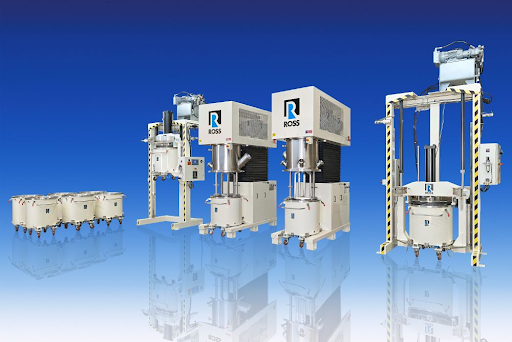Not long after, the double planetary mixer gained a reputation in areas related to coatings. Manufacturers of sealants and adhesives reaped clear processing benefits from their abilities to efficiently turn over sticky, viscous, or putty-like materials.
The industry’s demands are always changing, but twin planetary mixers and other planetary-style mixing equipment have become typical workhorses.
Upgraded Blades
Two identical blades in twin planetary mixers rotate on their axes as they orbit a shared axis. Blades contact the entire batch in 36 revolutions around the vessel.
While double planetary mixers have several agitators, the rectangular paddle-shaped blade was the most popular for years. Rectangular blades have slanted vertical flights and horizontal lower crossbars for radial and axial flow and sturdy construction.
Planetary Dual Dispersers
Add two high-speed shafts with saw-tooth blades to a double planetary mixer to create a planetary dual disperser for even greater shear intensity and faster dispersion of dry grains into a fluid batch. Larger and more frequent solid additions are possible with this robust system.
At least two saw-tooth blades are on each disperser shaft to break down agglomerates faster and increase turnover, especially in dense or sticky material.
Planetary Dispersers
Just like we said, two planetary mixers use high viscosity to create a lot of shear. The Planetary Mixers with low- and high-speed agitators is ideal for preparing shear-requiring formulations that do not yet achieve sufficiently high viscosities.
The device uses a single planetary blade and a high-speed shaft equipped with one or more saw-tooth disperser blades rather than two identical stirrers. With tip speeds of up to four thousand feet per minute, the disperser spins on its axis, allowing it to swiftly mix in raw materials.
As it moves material towards the disperser, the slower planetary blade sweeps the inside and outside of the vessel in a continuous motion. Additionally, it helps to distribute the heat generated by the saw-tooth blades and ensures that the batch stays at a consistent temperature.
Better Methods for Sealing
Beyond blade design, the double planetary mixer has undergone various upgrades to meet the needs of its most demanding consumers, many of whom are adhesive and sealant producers. Several gearbox and sealing solutions reduce product and machine contamination.
It is common practice to use PTFE lip seals to seal stirrer shafts. It is possible to get mechanical seals or double lip seals to make sure that no grease gets out of the gearbox. For shafts that will be exposed to harsh solvents, magnetic sealing is an additional option.
It is also possible for the gearbox to have a liquid seal or dust shield. The gearbox can be more easily cleaned between batches thanks to a Millet Broom and dust barrier mounted beneath it, which keeps product splash and dust from entering the gearbox.
Conclusion
Once the appropriate technology is chosen, rental unit tests can refine the mixing process. Manufacturers can check horsepower requirements, start manufacturing and operator training, or experiment with ingredient orders and processes for a fraction of the capital cost.


